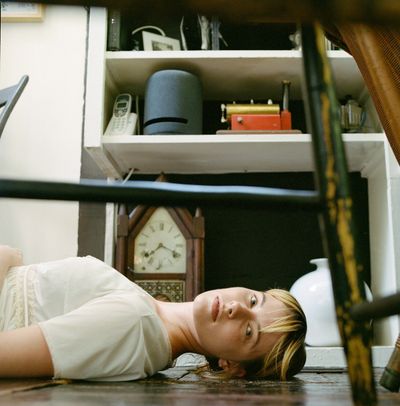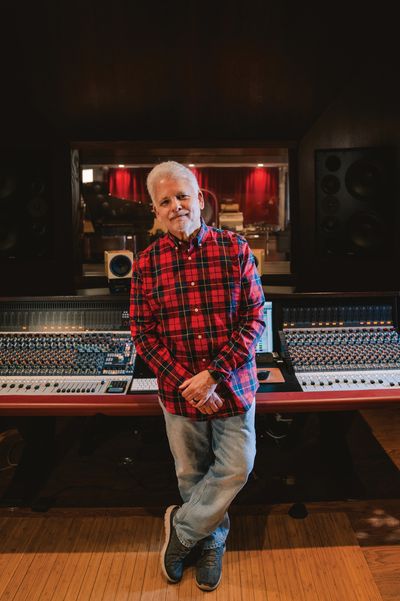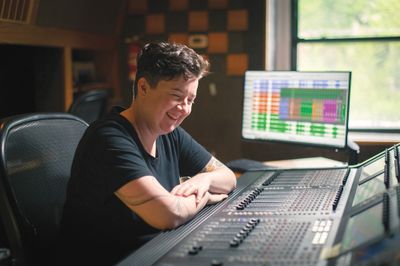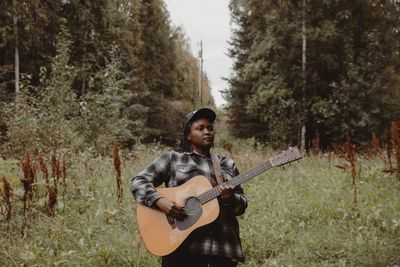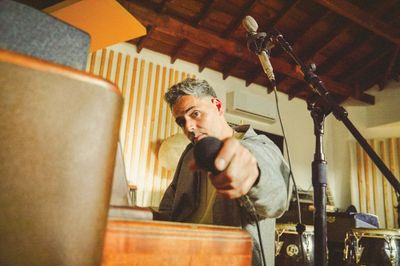You both demo separately in home studios. What do your individual setups look like these days?
Sara: I call it "my office." During the pandemic, I started trying to get myself to say "studio." People come over sometimes and ask, "Where's the room where you make music?" I was like, "Oh my god, I need to put guitars on the walls and keyboards out, so people don't think I'm a crazy person." I've always used Apple products. I record on a Mac. I've moved away from Pro Tools and now record exclusively in [Apple] Logic. I use a [Universal Audio] Apollo Twin interface. For all of my demos, I like an old Neumann microphone. That's it. I don't use outboard; I don't use crazy compressors, or equipment that would take up space. I do a ton of recording and demoing. And since The Con, a lot of demoing has ended up on our actual, official, squeaky-clean studio albums. You'd think that I'd be thinking, "Next time, there's a good chance a lot of my demos will be on the album. I'm going to record that better." [laughter] But I keep doing it the same way I've always done it.
Tegan: I use the same setup as Sara. I've been on Logic now since 2007. The other day I was in the studio and had to use Pro Tools. I felt pretty accomplished that I still remembered how to use it all these years later! I bought a cabin on an island off the coast of Vancouver a couple years ago. There's a little writer's shack – what they call a "bunkie" – on the property, which I'm sitting in right now. I have three guitars, an amp, and my computer set up to record if I want to. Which has proven to be confusing, because I'll bring my microphone with me somewhere, and I come back here and I'm like, "Why did I bring the microphone? I should just leave one in every place." So, I leave the microphone there, and I fly back to Vancouver. Then I don't have a Thunderbolt cable, so I can't use my interface. So, I order 42 new Thunderbolt cables. None of them are ever where I need to be! [laughter] I'm constantly calling my managers asking to postpone something because I don't have a Thunderbolt cable. I can hear them thinking, "Are you really a musician?"
For its great software, Mac has not made it easy to plug and play. I don't want any more dongles.
T: The dongles; it's so ugly! Our goal has always been simple. I remember one time I was in the studio with Carly Rae Jepsen, and she records everything on her phone. At the time, internally, I was like, "Come on, Carly." Now I think that's the way to go. Just make a voice memo on your phone.
There are some cool tools for phones these days. You used one in the writing of this album, right?
S: I used the Keezy app on my iPhone to make everything. It's fucking awesome. My partner, Stacy, her cousin was married to the guy who created it. He showed me Keezy almost ten years ago, and I was like, "This actually seems like something I could use." I don't have the patience to learn samplers; but this feels like it's built for children, so I felt I could use it. I fooled around with it a little bit and then I didn't think about it again. Then, when I started working on this album and writing songs, I had a folder on my phone with music-related things – a tuner, a metronome, and so on. I saw the Keezy app and opened it up, and I started making samples and sounds. My hard drives are filled with instrumentals, so sometimes I'd open an instrumental and sit with the Keezy app and make weird vocal loops. I didn't bother to figure out if I could hook my phone up to the computer and use it as a device; I'd hit record and I'd play the Keezy app into my microphone. On a lot of this album, I can hear my finger hitting the screen of my iPhone in certain samples. But at this point, it's all about capturing performance and excitement. Some of the technology I love is fabulous, but I get too in the weeds and it doesn't sound like anything. It loses whatever joy happens when I'm spontaneously writing. The thing I love about Keezy is there're not a lot of options. With less options, I find I have better, more robust, more creative ideas.
Tegan, am I right in thinking you worked in Reason, and that resulted in your first co-write with Sara?
T: Yeah. When we were writing The Con, Chris Walla [#19, #111] told us he wanted to record in [iZ Technology] RADAR. At that time, Sara and I had both shifted away from Pro Tools and were using [Apple] GarageBand, because I loved that it had all the drum loops and sounds in it. We had both just gotten new laptops and were off the road, so most of the songs on The Con I recorded into GarageBand. When [Chris] started listening to the demos, he was impressed. There was one song, "Are You Ten Years Ago," where he heard my drum programming and said, "You should try Reason." His drummer [Death Cab for Cutie's], Jason McGerr, got me a copy of Reason. I probably spent two weeks experimenting, playing around, and watching videos. The first piece of music I created out of it turned into a mess of sounds; I couldn't figure out how to control and stop and start everything, so I was just hitting buttons. So, I sent it to Sara and said, "Maybe this could be a collaboration?" She sent back "Paperback Head." I felt blocked – there were so many things happening at once, because I'd programmed so much, and I couldn't figure out where the melody could fit. Sara was able to hear it and sent it back, and I thought it was really cool. When we got in the studio to record it, I'm fairly certain we ended up starting from scratch and faking the sounds, because none of us could figure out Reason!
How does software inspire the initial arrangement process? Do you start out with programming drums?
S: I almost always start with a drum loop and rhythm. I'm thinking about tempo and the general skeleton of the drum arc. That's why I struggle so much with analog songwriting. I generally want to start with an instrumental first, and that always feels like magic to me. I can open a session and there's nothing, and suddenly there are tracks and tracks. I still find that a wonderful thing, the exploration of moving chunks of sound around, messing with them, and color coding them. It's very visual for me. I like being able to see in real time what I'm making, and knowing that it is somehow part of the alchemy that allows me to make music. Figuring out drum loops and how to make rhythm was mind blowing to me, and that became the exact way that I always like to write a song.
T: I tend to need to start with an organic instrument, even if I'm writing into Logic with chords. Increasingly, in the last ten years, I've gone back to writing on the guitar. Heartthrob and Love You To Death were the two albums where I wrote in the box, and then I went back to the good ol' guitar to see how it'd go. When I come up with a chord progression I like, or a section of a song, I almost immediately record it. I start to remove the guitar and add other instruments instead. On this record, I was really collaborative with Sara. As soon as I had an idea, I would record it and send it to her. We keep using the word "renovate." Sara would take the song and build new production, speed it up, sing it in her own voice, and give me feedback about what she wanted to hear. We'd never done that before. In the past, certainly for me, I spent a lot of time and energy on production. I didn't on this album. I just wanted to write songs. One of the songs on the album was a co-write with Caleb Shreve; he'd sent me a bunch of tracks ten years ago. I pulled up one of the songs and liked the track, learned the chords on guitar, and wrote a song from it. I did the same with a Sultan + Shepard track, and I did the same with a song of Sara's. She sent me a song called "Cynic," and I started messing around with it on the computer. It was industrial, it didn't fit the vibe of the record. It had seven different wild drum samples looping – it sounded ridiculous! But there was something about hearing the track and riffing over it melodically in the room. The second I found a hook I liked, I stopped playing with the track and took it back to guitar. Songwriting for me is not a pencil, paper, acoustic guitar, and a quiet room. It's trial and error. I find Logic helps me, because the second I have an idea I can start to tweak it.
Tell me about your high school recordings. It was such a rare experience at that time for kids to have access to recording equipment. Did any lessons stick with you?
T: Our broadcasting and communications class was a film and radio class, basically. We learned to make movies, or commercials, or we made jingles. But we immediately lost interest in it and started bringing our guitars to class. One of the years, we convinced our teacher to let us make a demo and use the other students in the class and submit it as a joint project. We learned to set up the equipment and get the guitar and vocal sounds we wanted – but it was all radio equipment, so it was horrible microphones and a digital board we could record into. It would record onto a cassette tape! It was all old and shitty, and it sounded old and shitty, but we were thrilled. It was monumental, because it immediately drew a parallel to the lore we understood: that Bruce Springsteen had recorded himself [on Nebraska]. We didn't know what an 8-track was, but we understood that Bruce Springsteen had recorded himself. So, in the early days of our music, it was like, "Well, we must record ourselves." There was no waiting around for someone to do it. There was no waiting for studio time, or money, or anything. We had barely written one song and we were like, "We must document this!"
S: As soon as we wrote a song, it was very normal for us to want to document something and listen to it. That's our natural progression into becoming the kinds of songwriters and producers we are: "I want to take my idea, put it into the machine, hear it back, and do things with it."
You've co-produced with some heavy hitters. Do you think they picked anything up from you?
S: The biggest flattery is anyone who lifts the hood on our sessions and says, "Oh my god, how did you make that weird sound?" Anyone who's ever tinkered in our sessions, all the way back to John Collins [Tape Op #27] and David Carswell, all the way up to Chris Walla and Greg Kurstin [#135], were producers I was really nervous to let look around. I had enough sense to think, "Greg is going to open my session and go, 'You maniac, what is this?'" It would give me a thrill if he found a keyboard sound and ask, "How did you engineer this to sound this way?" A lot of times Greg would try to make the sound using his analog gear and fancy studio equipment, and every once in a while he'd turn around and be like, "I'm just using yours. I cannot duplicate this." I don't know if there's a definable, articulate way we do it, but I know we're able to make unique sounds. Certainly, producers have always approached our vocals really specifically, and I think where we've sounded the best and thrived is when we dictate our vocal sound. We know that when producers let us lead, it yields better or cooler sounding results. We've been lucky to almost exclusively have co-producers who boost our confidence.
T: On our first collaboration with Jared Kuemper, he convinced us to use Pro Tools. This was back in 1999 and nobody was really using it. It set the precedent that experimenting in the studio is a good thing, and using technology is a good thing. What we learned from each of them was to believe in our ideas and production. Chris Walla was the first person to really dive into our production. If he wasn't using something that we'd recorded, he'd have us recreate it in the studio with the help of a different keyboard or an organic instrument. He was the first person to say, "What you're doing is really interesting, and we should replicate it or use it." After that, even Greg Kurstin built our confidence in the studio by telling us what we'd made was weird and cool. We're a bit wonky; our songs are a bit strange and we make strange choices. We always work with musicians who are also producers, and they help us figure out how to make it listenable and more playable. But they also contribute a tremendous amount of coins into the self-esteem bank. Recently we were interviewing John Congleton and talking about co-production credits in the studio, and he said such a cool thing. He said, "I feel like every record I've made probably should have been a co-production with the artist I was making it with, in hindsight." Most of the artists he's working with are like us: we come in with all the ideas set. We have a crazy blueprint, and a vision, and that's from recording at home. That demoing process is when we build the story of what the record will be. The pre-production is all us, and there's an enormous amount of production we do before we get in the studio. I think of some of the records people love most: we don't have [production] credit on them, and we honestly should probably have. I'm not resentful; it's not about points, or royalties, or anything like that. I just thought John said it in such a great way. That made me happy.

There are so many, as you put it, "weird sounds" on your records, that I've assumed came from pre-production because they're so specific. It can be hard to tap into that level of architecture in the studio. I'm curious about your mixing process, because there must be so many layers of tracks.
S: On this record, John insisted that he mix it. He has a method to his madness – not to say his sessions are madness. But he has a signature, and we tried to respect that. Over the years, certain producers have a vision and feel strongly they should be at the mixing board making those decisions as part of the production. Then we've worked with the types of producers who see mixing as its own unique skill and add a fresh set of ears to the process. I'm glad we've done both. With this album, there was a lot going on. John understands his own shorthand and own tricks and he knew what he wanted from the album; he needed to put it all together. When we were making the credits, I was like, "What did you keep of ours? What is yours?" He was like, "I don't know!"

T: I think that's an example that we mostly have highly collaborative partnerships in the studio. We all were there, and everybody did a bunch of things. Crybaby and The Con are sister albums, in my head. Chris Walla was saying this about The Con recently, but [those albums are] messy in a way. But that's us! It's still slick as fuck, but there's an organic-ness; a vibe. There was a lot of layering of parts. John would say, "Yesterday I opened the session and laid more things down." Luke Reynolds, who was there, would come and layer eighty-five different parts.
And Joey Waronker, too. So many great producers play on this album.
T: Yeah! So many parts and ideas happening, and it sounds like that – in the best way, in my opinion. We had one directive for this album: find joy in performing again. We needed to make a record that felt like a joy recording it, so it could translate live. I think that's in the production.
You're both involved with the organizations We Are Moving the Needle and Women in Music Canada. I'm curious about the personal significance of working on missions toward gender equity in recorded music.
S: I think it starts in your own project. As Tegan and I built a touring and collaborative world, we always cared about how we engineer diversity in those projects and make sure we're being mindful about our values, as well as how we can level up and make opportunities for other people. People made opportunities for us, so it's a pay-it-forward type thing. Obviously, in the music industry it's very easy to find a bunch of white, straight cis guys to populate your projects. There are statistically way more of them! It takes a little more work to find other kinds of folks to go out and fill those roles. Specifically, the technical roles on tour are the highest paid positions: the people doing front of house, lighting directors, and production managers. Actively putting time and effort into supporting people trying to get their first big gig – and maybe don't have the resume that a guy does – that became really important to us. To see that work and ethos formalized in an organization makes it easy for us to attach our names. It's not an easy fix. It's ongoing work, and I imagine we'll all be doing it for the rest of eternity. ![]()
